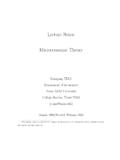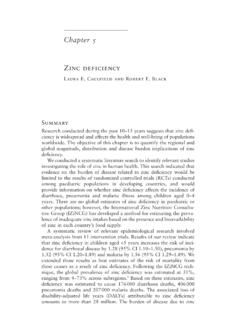Transcription of Control of Pollution in the Iron and Steel Industry
1 UNESCO EOLSSSAMPLE CHAPTERSPOLLUTION Control TECHNOLOGIES Vol. III - Control of Pollution in the iron and Steel Industry - D. L. Doushanov Encyclopedia of Life Support Systems (EOLSS) Control OF Pollution IN THE iron AND Steel Industry D. L. Doushanov Department of Fuel, Institute of Organic Chemistry, Bulgarian Academy of Sciences, Bulgaria Keywords: Environmental Pollution , Sintering, Cokemaking, Ironmaking, Direct reduction, Steelmaking, Ferroalloy Industry , Rolling, Skarfing, Pickling, iron foundries, Steel foundries, Alternative technologies. Contents 1. Introduction 2. Sinter production: Control of Pollution 3. Coke production: Control of Pollution 4. iron production: Control of Pollution Ironmaking Direct reduction to iron 5.
2 Steel production: Control of Pollution Basic oxygen process Electric Arc Furnace Electric Arc Furnace Dust Treatment 6. Ferroalloy Production: Control of Pollution 7. Rolling: Control of Pollution 8. iron foundries: Control of Pollution 9. Steel foundries: Control of Pollution 10. Concluding remarks Glossary Bibliography Biographical Sketch Summary The iron and Steel Industry causes significant effects on environmental media air, water and soil. In the sinter plants the dominant emissions generated from material handling, windbox exhaust, disharge end, and cold screen are particulate emissions - mainly iron oxides, sulfur oxides, calcium oxides, hydrocarbons, carbonaceous compounds, and chlorides. Emission of particulate matter, carbon monoxide, sulfur dioxide, organic compounds and other pollutants originate from several operations in the coking plants.
3 Emissions from the blast furnace are generated from the top, in the casting stages, by drilling and plugging the taphole. During the casting operation, iron oxides, magnesium oxide and carbonaceous compounds are generated. The most significant emissions from the basic oxygen process are emitted during the oxygen blow period: iron oxides, mainly heavy metals and fluorides. The operations which generate emissions during the electric steelmaking are: melting - iron oxide; refining - calcium oxide from the slag; charging - iron and metallic oxides from alloy in the scrap; dumping slag and tapping Steel - iron oxides and oxydes from the fluxes. During the UNESCO EOLSSSAMPLE CHAPTERSPOLLUTION Control TECHNOLOGIES Vol.
4 III - Control of Pollution in the iron and Steel Industry - D. L. Doushanov Encyclopedia of Life Support Systems (EOLSS) semifinished product preparation the Pollution is produced from the pouring of the molten Steel into ingot molds and when semifinished Steel is scarfed. Open dust sources include vehicle traffic; raw material handling and wind erosion from storage pile and contribute to the atmospheric Pollution . The polluting emissions in the iron and Steel Industry are controlled by a variety of evacuation systems, devices, and methods such as cyclone cleaners, dry or wet electrostatic precipitators, scrubbers, bag houses, hoods, funrace enclosures; chemical, catalytic and biological methods. 1. Introduction The main types of plants involved in iron and Steel Industry are sintering plants, blast furnaces and Steel works, direct reduction plants, ferroalloy production, rolling, scarfing, pickling, iron and Steel foundry, and other technologies, such as argon - oxygen decarburization, ladle metallurgy vacuum degassing.
5 Coking plants are considered here as part of this sector, since coke is produced practically exclusively for the iron and Steel Industry . The iron and Steel Industry causes significant effects on environmental media: air - emissions of SO2, NO x, CO, H2S, PAH, lead, Ni, As, Cd, Cr, Cu, Zn, Se, Hg, PM, etc.; water - process water with organic matter, oil, metals, suspended solids, benzene, phenol, acids, sulfides, sulfates, ammonia, cyanides, thiocyanates, thiosulfates, fluorides (scrubber effluent); soil - slag, sludge, sulfur compounds, heavy metals, oil and grease residues, salts. The environmental sustainability of the blast furnace with its upstream stages coking and sintering plants is of great significance if existing capacities are to be retained or new ones are to be built.
6 The blast furnaces built over the past years thus have a similar standard of environmental protection, independent of the location. The blast furnace process will remain the basic member in the technological chain of Steel production in a foreseeable future. The coke production remains an inseparable part of the Steel production. The needs for coke in the future will depend to a great extent on the factors influencing the reduction of these needs or rather on the possibility for alternative technologies to replace the blast furnace process. In 1995, about 358 million tones of coke have been produced in the world by 250 coke plants. Steel will remain the basis for economic development in the world. It is used to produce everything from sewing needles and tools to automobiles, ships and planes.
7 Steel consumption will tend to follow the development in gross national product in the world. In accordance with the IISI,s data the total world Steel production in 1997 was 793 million tons. The Protocol agreed at the Conference in Kyoto (1997) set out commitments to limit greenhouse gas emissions for industrial countries for the period 2008-2012. For example, emissions of CO2 only from fossil fuel combustion increased from Gt (1971) to Gt (1995) in the world. This document is very important for engineers, scientists and operators to implement technology strategies and public policies that UNESCO EOLSSSAMPLE CHAPTERSPOLLUTION Control TECHNOLOGIES Vol. III - Control of Pollution in the iron and Steel Industry - D.
8 L. Doushanov Encyclopedia of Life Support Systems (EOLSS) prevent, reduce, or eliminate adverse environmental consequences in the iron and Steel Industry . From the standpoint of the new millennium there must be realized a change from a technology for fulfilling primary requirements only, to the development of modern, sustainable iron and Steel technology within human activity in coexistence with environment on a global scale. 2. Sinter Production: Control of Pollution Sinter plants have to fulfill increasing environmental regulations. For this plant manufacturers and operators had to develop new technical solutions for the reduction of Pollution . Presently relevant new equipment has been installed at several sinter plants.
9 For various pollutants, especially for dioxins and furanes further efforts are currently undertaken. For the blast furnace the future availibility of high quality sinter is of great importance because very few lump ores comply with the quality requirements of the blast furnace. Alternative quality feeds are limited in supply. This applies for pellets. The sintering converts fine-sized raw material, iron ore, coke breeze, limestone, mill scale, and flue dust into an agglomerated product (sinter) at suitable size for charging into the blast furnace. The raw materials are sometimes mixed with water to provide a cohesive matrix and then placed on a travelling grate called the sinter strand. A burner hood, at the beginning of the sinter strand ignites the coke in the mixture.
10 The combustion provides sufficient heat, from 13000C to 1480oC, to cause surface melting and agglomeration of the mix. On the underside of the sinter strand there is a series of wind boxes that draw combusted air down through the material bed to a gas cleaning. The fused sinter is discharged at the end of the sinter strand, where it is crushed and screened. The remaining sinter product is cooled in open air or in a circular cooler with water sprays or mechanical fans. The cooled product is crushed and screened for a final time, then the fines are recycled, and the product is sent to the blast furnaces. Practically two and a half tons of raw materials are required to produce one ton of product sinter. The Pollution from sinter plants is generated from handling of raw material, wind box exhaust, discharge, cooler and cold screen.
















